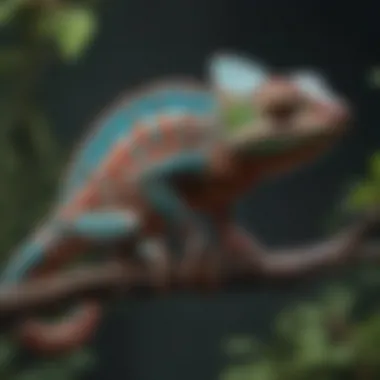Essential Guide to Veiled Chameleon Care and Maintenance


Intro
Veiled chameleons are fascinating creatures, beloved for their ability to change color and their unique appearance. This article provides a thorough understanding of the care these reptiles need. Knowing how to meet their requirements is essential for their health and happiness.
In the sections to come, we will explore various aspects of veiled chameleon care. Readers can expect insights into their behavioral tendencies, dietary needs, and habitat preferences. Attention will also be given to health monitoring, environmental enrichment, and the importance of social interactions.
By the end of this guide, pet owners and enthusiasts will feel equipped with the knowledge necessary to create an optimal living environment for veiled chameleons, ensuring these remarkable animals thrive in a home setting.
Understanding Your Pet
Pet Behavior Basics
Understanding veiled chameleon behavior is key to ensuring their well-being. These reptiles communicate largely through body language and color change. A relaxed chameleon will often display bright, vibrant colors, whereas stress can lead to darkening of their skin.
Additionally, veiled chameleons are naturally solitary in the wild. They may not appreciate the presence of other reptiles and should ideally be housed alone to minimize stress. Observing their behavior helps in identifying what they need, whether it's a more private spot or interaction when they're feeling more social.
Common Breed Characteristics
Veiled chameleons, scientifically known as Chamaeleo calyptratus, are distinct for their prominent casque—a horn-like structure on their heads. They typically exhibit a variety of colors, including green, yellow, and blue. Males are generally larger than females, and they can grow up to 24 inches long, while females average around 10 to 14 inches.
These reptiles are known for their territorial nature and will display aggressive behaviors if they feel threatened or crowded.
Species-Specific Needs
To care for a veiled chameleon, it is crucial to mimic their natural environment. They require a habitat with ample vertical space, as they prefer to climb. Optimal temperatures need to be maintained, usually a basking spot of around 95°F to 100°F and a cooler area of 75°F to 80°F. Humidity levels should be kept between 40% and 70% during the day, with higher humidity at night.
Pet Care and Maintenance
Feeding Guidelines
Feeding your veiled chameleon requires careful attention to their dietary needs. They are primarily insectivores and should be fed a variety of insects, including crickets, roaches, and mealworms. It is important to provide a balanced diet, incorporating calcium and vitamin D3 supplements to prevent metabolic bone disease.
A proper feeding schedule involves giving live food every other day, while also incorporating occasional fruits and vegetables like spinach and butternut squash. Ensure that the insects offered are of appropriate size—no larger than the width of the chameleon’s head.
Grooming Essentials
While veiled chameleons do not require extensive grooming, regular handling can help them get accustomed to human interaction. Avoid excessive handling, as they can be stressed by it. It's also essential to keep their habitat clean and avoid leaving uneaten food in the enclosure, as it can attract pests.
Hygiene Practices
Hygiene is a vital part of chameleon care. Regularly clean their enclosure and replace substrate as needed. Additionally, providing a water source such as a drip system or a misting system helps keep humidity levels appropriate and ensures fresh water is always available.
Health and Wellness
Routine Vet Check-ups
Establishing a relationship with a veterinarian experienced in reptile care is important. Routine check-ups can help catch any potential health issues before they become serious. Depending on the chameleon's age and overall health, these check-ups may be performed semi-annually.
Vaccination Needs
Unlike some other pets, chameleons do not require vaccinations. However, monitoring their diet and overall living conditions can help prevent diseases that could arise from improper care.
Recognizing Signs of Illness
It is essential to be aware of signs that might indicate illness in a veiled chameleon. Sudden color changes, lethargy, lack of appetite, and unusual droppings can all suggest health issues. If any of these symptoms appear, immediate veterinary attention is advisable.
Enrichment and Activities
Indoor vs.
Outdoor Activities
Creating a stimulating environment is critical for a veiled chameleon's mental health. Indoor habitats should have climbing branches, plants, and hiding spots. Outdoor time should be limited and supervised to prevent stress or escape.


Interactive Toys and Games
While chameleons don't play in the same way as traditional pets, incorporating a variety of ornaments and natural obstacles in their habitat can encourage exploratory behavior. Using foraging methods during feeding can also keep them engaged mentally.
Socialization Opportunities
Though inherently solitary, acclimatization to human interaction fosters a calmer pet. Spend quiet time near their enclosure, gradually gaining their trust. Use slow movements to avoid startling them. Socialization aids in reducing stress, promoting a healthier living experience.
Remember, the key to a thriving veiled chameleon lies in understanding its specific needs and responding to them effectively.
In summary, veiled chameleons are unique and fascinating pets that require dedicated care. By understanding their behavior, habitat needs, and health requirements, you can provide a nurturing environment for these reptiles. With thoughtful practices and observation, owning a veiled chameleon can be a rewarding experience.
Foreword to Veiled Chameleons
Understanding veiled chameleons is crucial for both current and prospective owners. These reptiles are not just another pet; they are unique creatures that require specific care and attention. This section will provide insights into their origins, natural habitats, and distinctive features, which can help owners appreciate their pet's needs more deeply.
Origin and Natural Habitat
Veiled chameleons, scientifically known as Chamaeleo calyptratus, hail from the arid regions of Yemen and Saudi Arabia. By understanding their native environment, we can grasp why certain conditions are necessary for their health in captivity. In the wild, these chameleons enjoy a tropical climate, featuring warm temperatures and moderate humidity levels. They typically live in trees and shrubs, where they can easily blend in with foliage. This habitat allows them to hunt insects and evade predators.
When setting up a home environment, replicating these conditions is vital. A larger enclosure filled with branches, leaves, and other climbing structures will mimic their natural surroundings. Additionally, the enclosure must be kept at a warm temperature while providing adequate humidity through water sources or misting systems. By providing a habitat that closely resembles their natural environment, owners can help their veiled chameleons thrive.
Distinctive Features and Characteristics
Veiled chameleons are easily recognizable due to their unique physical traits. They possess a crest of spiny scales on their heads and backs, giving them their common name. Their color can vary significantly, ranging from green and yellow to brown. This ability to change color is not just for aesthetic purposes; it reflects their mood, health, and temperature needs. A stressed chameleon may appear dull, while a happy one can be vibrant and colorful.
Furthermore, veiled chameleons have independently moving eyes, allowing them to survey their surroundings without moving their heads. This feature aids in spotting both prey and potential threats while being perfectly still. Understanding these characteristics can enhance the owner's ability to care for these reptiles, as observing their behavior will provide insights into their general well-being.
Recognizing behavioral signs in chameleons can help detect health issues early.
Overall, an appreciation of their origin and characteristics can lead to effective care and a stronger bond with your veiled chameleon.
Choosing a Veiled Chameleon
Choosing a veiled chameleon as a pet is an important decision that requires careful consideration. Veiled chameleons are known for their unique appearance and fascinating behaviors, but they also have specific care needs that must be met. The right choice can lead to a rewarding experience, while the wrong choice might lead to frustration and health issues for the chameleon.
When considering adding a veiled chameleon to your household, you should think about where to acquire one. This will impact the animal's health, adaptability, and overall lifespan. Proper knowledge about the source can ensure that you obtain a healthy animal that can flourish in your care.
Pet Store vs.
Breeder
When deciding whether to buy a veiled chameleon from a pet store or a breeder, each avenue has distinct advantages and disadvantages. Pet stores often provide convenience; however, the quality of care can vary greatly within these establishments. Chameleons at pet stores might not receive adequate husbandry before they reach your home. Moreover, it may be difficult to verify their health history, which is crucial in ensuring you are getting a healthy pet.
On the other hand, breeders often have more extensive knowledge regarding their chameleons. They usually maintain better living conditions and can provide health information as well as insight into the specific traits of the chameleons they raise. If possible, confirm that the breeder follows ethical practices and raises their chameleons in suitable environments. This can have a positive impact on the long-term health of the animal you choose.
Consider visiting both a pet store and a breeder, if possible. Observe the conditions of the chameleons and ask questions about their care. This firsthand experience is valuable.
Signs of a Healthy Chameleon
Identifying the signs of a healthy veiled chameleon is crucial in making your choice. Healthy chameleons generally exhibit certain characteristics.
- Bright and clear eyes: They should not appear cloudy or dull.
- Smooth and vibrant skin: Look for bright coloration and no signs of shedding problems.
- Active behavior: A healthy chameleon will be alert and move around its enclosure.
- Proper posture: They should hold themselves upright and show a curiosity in their environment.
If you notice any lethargy or abnormal behavior, it is best to make sure the animal is healthy before purchasing. A knowledgeable breeder or pet store employee should be able to help you evaluate these factors effectively. Ensuring you select a healthy veiled chameleon will ultimately contribute to a more enjoyable and rewarding pet ownership experience.
Choosing a healthy veiled chameleon is the first step in ensuring a thriving pet that can provide companionship and interest for years to come.
Habitat Setup
Creating a proper habitat is crucial for the well-being of veiled chameleons. These reptiles require specific conditions to thrive, mimicking their natural environment. Understanding the components of an appropriate habitat will help in ensuring these creatures remain healthy and stress-free. A suitable habitat setup provides comfort, supports natural behaviors, and prevents health issues. Each element must be carefully considered to meet their unique needs.
Enclosure Size and Type
Veiled chameleons need a spacious enclosure to exhibit their natural climbing behaviors. It is generally recommended to choose a vertical cage rather than a horizontal one. A 24x24x48 inch enclosure is often considered a minimum for an adult chameleon. This size allows for effective climbing and basking areas. The material of the enclosure is also vital; glass or screen cages are preferable. Screen cages promote airflow, while glass cages can maintain humidity levels more effectively.


Key Considerations:
- Vertical Space: Prioritize height over width to allow for climbing.
- Ventilation: Good airflow prevents stagnant air, reducing the risk of disease.
- Ease of Access: Consider how easy it is to clean and maintain the enclosure.
Temperature and Heating Requirements
Temperature control is essential for a veiled chameleon’s environment. They thrive in a gradient temperature setup; it is best to have a basking area of around 85-95°F. The cooler side of the enclosure should range between 70-80°F. This gradient allows chameleons to self-regulate their body temperature.
Heating Sources:
- Basking Bulbs: These should provide UVB light and heat.
- Ceramic Heat Emitters: Useful for maintaining nighttime warmth without light disruption.
Maintaining an appropriate temperature is vital to prevent metabolic issues or stress in your chameleon. Regular monitoring using thermometers will help ensure conditions remain optimal.
Humidity and Water Sources
Humidity levels are another critical factor in habitat setup. Veiled chameleons typically require humidity levels of 40-60%. However, these levels should be higher during the nighttime. Mistaking the habitat or using a drip system can help achieve good humidity. A hygrometer can be used to monitor humidity levels accurately.
Watering Method:
- Misting: Mimics natural rain, promoting hydration.
- Drip Systems: Offers a consistent water source, useful during the day.
Maintaining proper humidity levels helps in shedding and hydration, both of which are important for the health of chameleons.
Decor and Environmental Enrichment
The decor and environmental enrichment of the chameleon's enclosure should recreate their natural habitat as closely as possible. Branches, plants, and vines can provide climbing opportunities and hiding places, helping the animal feel secure.
Recommended Decor Elements:
- Live Plants: Such as pothos or hibiscus; these plants can provide both climbing surfaces and humidity.
- Branches and Vines: Ensure these are safe and solid to support the weight of the chameleon.
Adding these elements creates a stimulating environment that encourages natural behaviors, reducing stress and promoting overall well-being.
Healthy environments lead to healthy chameleons. Proper habitat setup is the foundation for your pet's happiness and health.
Feeding and Nutrition
Feeding and nutrition are crucial for maintaining the health and overall well-being of veiled chameleons. These reptiles have specific dietary requirements that must be met to ensure they thrive in captivity. A well-balanced diet not only supports their bodily functions but also enhances their vibrant colorations and overall vitality. Providing adequate nutritional components can increase their immune response and potentially extend their lifespan.
Dietary Needs and Recommendations
Veiled chameleons are primarily insectivores, which means their diet should mainly consist of live insects. Suitable options include crickets, mealworms, superworms, and roaches. It's important to choose insects that match your chameleon's size and ensure they are gut-loaded, which means feeding them nutritious foods before they become a meal.
Insect Varieties:
- Crickets
- Mealworms
- Superworms
- Dubia roaches
Offering varieties can prevent dietary boredom and ensure a more comprehensive nutrient intake. Alongside insects, some chameleons can be given leafy greens and fruits, but this should only be a small fraction of their diet. Popular choices for greens include collard greens, kale, and dandelion greens.
Supplementation and Nutrient Importance
Chameleons require certain vitamins and minerals to avoid deficiencies. Supplementation plays an integral role in their nutrition. It is advisable to dust insects with a calcium supplement that does not contain vitamin D3 at every feeding. This helps strengthen their bones and promote healthy growth. Additionally, using a multivitamin supplement once or twice a month will provide essential nutrients that may be lacking in their diet.
Key Supplements:
- Calcium without Vitamin D3 (dust insects)
- Multivitamins (once or twice monthly)
Furthermore, it is essential not to over-supplement, as this can lead to health complications. The balance between calcium and phosphorus is particularly important; the ratio of calcium to phosphorus should ideally be at least 2:1.
Feeding Frequency and Techniques
Young veiled chameleons tend to eat more frequently than adults, generally requiring daily feedings. Adult chameleons can be fed every two to three days, adjusting the amount based on their size and activity level. When feeding, offer a variety of insects in a single feeding session to meet their dietary needs.
Tips for Feeding:


- Monitor eating habits and adjust frequency accordingly.
- Provide a shallow dish for insects to prevent them from escaping.
- Observe your chameleon during feeding to ensure it is eating and healthy.
Regular observation of feeding behavior can help in identifying any potential health issues early on.
In summary, proper feeding and nutrition are essential for the care of veiled chameleons. Understanding their dietary needs, ensuring proper supplementation, and establishing a consistent feeding regimen can significantly impact their overall health and quality of life.
Behavioral Insights
Understanding the behavioral patterns of veiled chameleons is essential. These reptiles exhibit unique and sometimes complex behaviors that reflect their natural instincts and environmental adaptations. By gaining insights into their behavior, pet owners can create a more accommodating habitat and foster a healthier relationship with their chameleons. Correctly interpreting their actions allows owners to prevent stress and ensure overall well-being. The focus on behavioral insights is not simply academic; it is fundamental to promoting harmony in a pet-owner relationship.
Understanding Chameleon Behavior
Veiled chameleons are known for their distinct personalities and behaviors. Observing their interactions can be both interesting and informative. They primarily exhibit three types of behaviors: territorial displays, basking, and feeding habits.
- Territorial Displays: Male chameleons often show aggressive behavior towards one another. They might puff up their bodies, display bright colors, or hiss. Recognizing these actions helps owners avoid unnecessary conflicts and stress.
- Basking: Chameleons are ectothermic, meaning they depend on external heat sources. Observing how frequently a chameleon basks can indicate its comfort level with the current environmental temperature. If it rarely basks, that may suggest the habitat is too cold.
- Feeding Habits: Chameleons prefer live food. They exhibit a slow, calculated approach when targeting prey, which is essential for their hunting instincts. Encouraging this behavior can greatly enhance their feeding experience.
Understanding these behaviors enables pet owners to adjust their habitat and feeding strategies effectively. This proactive approach not only maintains the pet's health but also promotes more natural behaviors.
Handling and Human Interaction
Handling a veiled chameleon requires caution and understanding. These reptiles are not social animals by nature and can become stressed by excessive handling. Here are a few important considerations when it comes to interaction:
- Frequency of Handling: Limit handling sessions to once or twice a week to avoid stress. Sudden or rough movements can make the chameleon feel threatened.
- Gradual Introduction: When first introducing your hands, do so slowly and gently. Allow the chameleon to explore your hand by placing it near its perch.
- Comfort Level: Always observe the chameleon’s body language. If it begins to change colors or displays defensive behavior, it’s best to return it to its habitat.
Important Note: Frequent handling can lead to health issues or behavioral problems, so it’s crucial to prioritize their comfort and well-being.
Overall, understanding behavior is crucial for maintaining a healthy and thriving environment for veiled chameleons. Educating oneself on how to best interact with them allows owners to foster an atmosphere that reflects their unique needs. This awareness not only enhances the pet's quality of life but strengthens the bond between the pet and its owner.
Health and Wellness
Health and wellness are crucial aspects of owning a veiled chameleon. By understanding these elements, owners can ensure their pets thrive in a home environment. Healthy chameleons exhibit vibrant colors and active behavior. In contrast, health issues can lead to lethargy and dull coloration. Recognizing the signs of potential health problems is essential for prompt intervention.
Common Health Issues
Veiled chameleons may encounter various health issues. Awareness of these common problems can lead to better preventive care. Some notable health concerns include:
- Metabolic Bone Disease (MBD): Often due to insufficient calcium and UVB exposure, leading to weakened bones and deformities.
- Respiratory Infections: Caused by high humidity and poor ventilation, resulting in sneezing and lethargy.
- Parasites: Various parasites can infest chameleons, leading to weight loss and poor health.
- Dehydration: Insufficient water intake or too low humidity results in serious health risks. Signs include sunken eyes and wrinkled skin.
To combat these issues, regular observation of dietary habits and physical condition is beneficial.
Prevention and Regular Health Checks
Preventive care is vital for maintaining the health of veiled chameleons. Regular health checks can help catch issues early. Here are some essential preventive steps:
- Provide a Balanced Diet: Ensure a varied diet rich in calcium and vitamins. Include insects and fresh greens.
- Monitor Environmental Conditions: Keep an eye on temperature and humidity levels. Make adjustments as needed to create a suitable habitat.
- Schedule Veterinary Visits: Regular check-ups with reptile veterinarians can identify problems before they escalate.
- Observe Behavioral Changes: An active and alert chameleon is generally a healthy one. Any changes in behavior can indicate health concerns.
Maintaining health and wellness in veiled chameleons requires diligence and knowledge.
With attentive care, owners can foster a thriving environment for their chameleons. This approach minimizes risks associated with common health issues and ensures a long, vibrant life for these unique pets.
Finale
The conclusion is a pivotal element of this article, as it consolidates the knowledge shared throughout the guide on veiled chameleon care. By summarizing key points, it allows readers, especially pet owners and animal lovers, to grasp the fundamental considerations necessary for maintaining a healthy veiled chameleon in their homes.
In reviewing the essential aspects such as habitat setup, nutrition, and behavioral insights, the conclusion emphasizes their interconnectedness and importance. Each section, while thorough, can feel overwhelming without a contextual synthesis. The final thoughts provide clarity, distilling the information into actionable insights.
Moreover, veiled chameleons, with their unique needs and characteristics, require a dedicated approach. Addressing practical details like temperature control, humidity levels, and feeding schedules is critical for their well-being. Understanding these elements means that owners can create an optimal environment that supports the health and happiness of their pets.
"Taking care of a veiled chameleon requires commitment and knowledge to ensure their thriving and vibrant life."
Including this conclusion helps reinforce the message that responsible ownership is crucial. It encourages careful consideration of the various needs of these reptiles and inspires a deeper appreciation for them as pets. By re-evaluating the information provided, readers can be better equipped to provide for their veiled chameleons’ complex needs. This holistic approach ultimately enhances the experience of keeping these fascinating creatures.
Final Thoughts on Veiled Chameleons as Pets
Veiled chameleons are remarkable pets, but they come with their own sets of challenges. Understanding their behaviors and needs is critical for both new and experienced pet owners. These reptiles are not simple animals; they require specific environmental conditions and nutrition to thrive.
When considering a veiled chameleon as a pet, think about the long-term commitment involved in caring for them. Setting up the appropriate habitat with the right dimensions, temperature controls, and humidity levels is the first step.
Also, remember that their diet must be varied. Insects such as crickets and roaches, along with supplements, contribute to their health. Observing their behaviors can also help identify any issues early on.
Final thoughts should encourage potential owners to research extensively and prepare well. Emphasizing the responsibility tied to adopting a veiled chameleon will demonstrate that they require more than just a basic setup. Instead, fostering an enriching environment for these lizards will contribute to their well-being and longevity. Investing time and effort into understanding their needs pays off in healthy and thriving pets.







